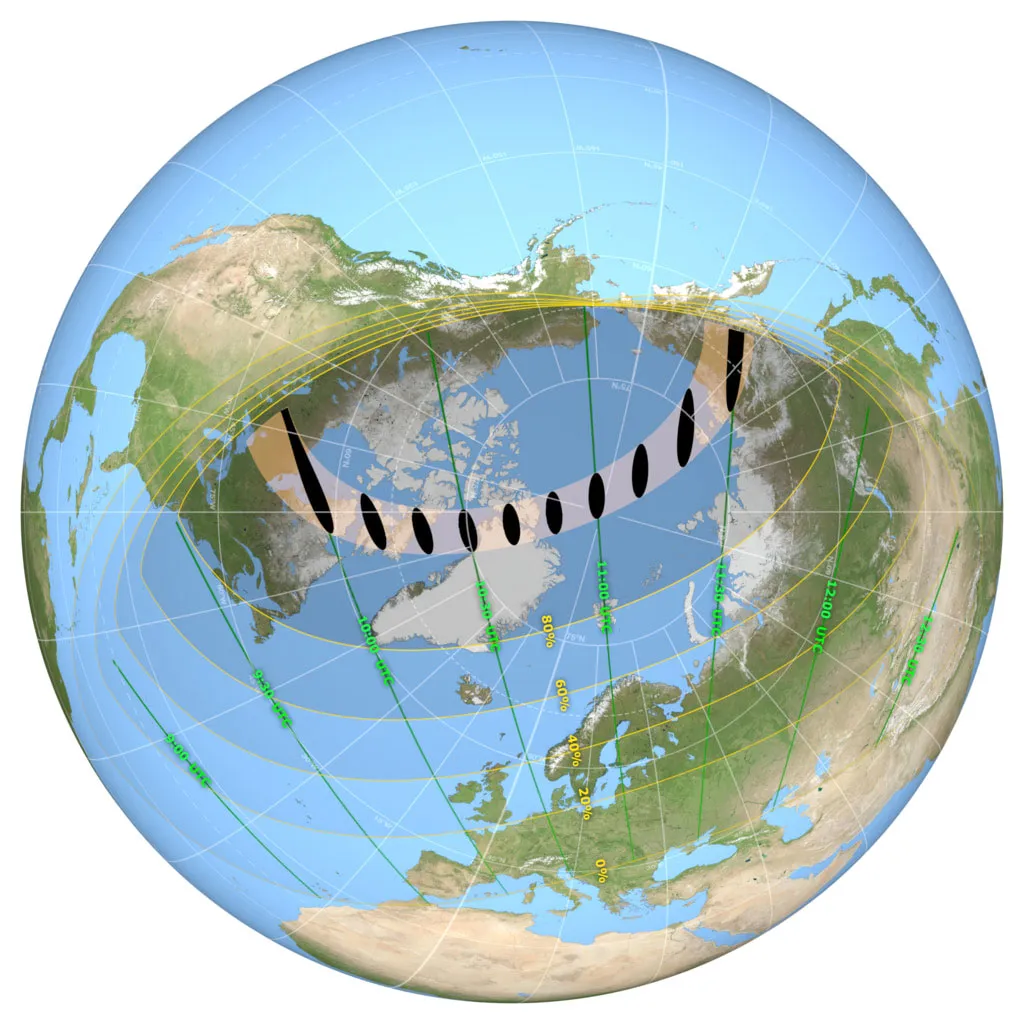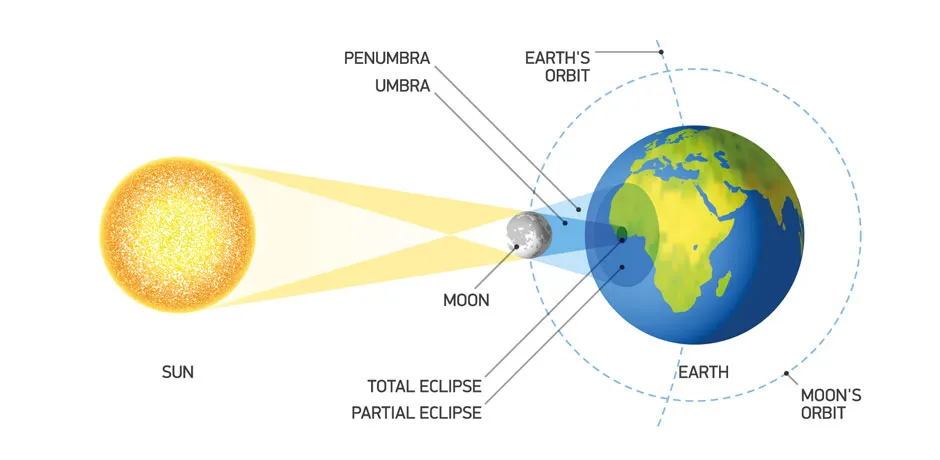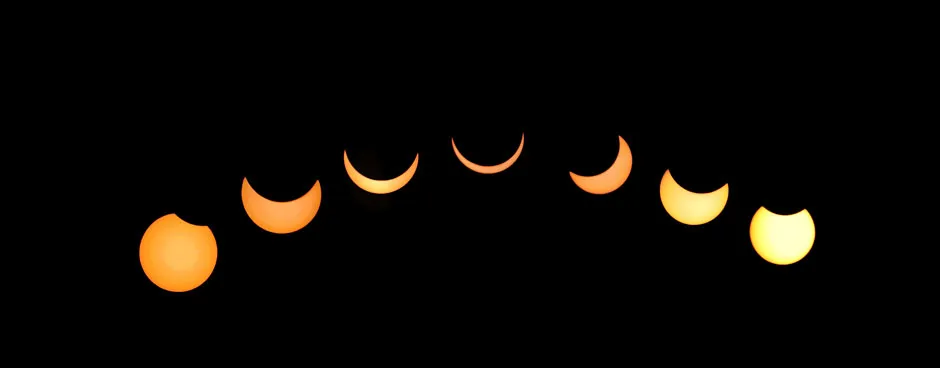This is not a drill: from 10:07am on Thursday 10 June, people across the UK witnessed a partial solar eclipse.
In Scotland, during the eclipse’s peak (11:14am) over a third of the Sun was blocked out by the Moon’s shadow. Meanwhile, a fifth of the Sun was obscured in southern parts of the UK, such as London.
Other parts of the northern hemisphere, such as areas of Greenland and the Arctic, managed to see a more spectacular sight. With the Moon almost covering the Sun completely, a full ‘ring of fire’ swept across the sky in what’s called an annular solar eclipse.
But why did the solar eclipse 2021 happen in the first place? When will the next one be in the UK? With the help of Dr Darren Baskill – astrophotographer and astronomy lecturer at the University of Sussex – all of these questions (and more) are orbiting below.
If you missed the eclipse, don’t worry: you can see our curated gallery of the best 2021 solar eclipse pictures now.
There are plenty of other astronomical wonders you can see in the sky later this year. Check out our full Moon UKcalendar andmeteor shower UKcalendar, and ourastronomy for beginnersguide.
What time was the solar eclipse today in the UK?
The partial solar eclipse 2021 started at10:07am BSTtoday,Thursday 10 June,in the UK.
It reached its maximum at 11:14am, concluding at 12:26pm.
Unfortunately, due to cloudy weather across the UK – particularly in south Wales and southwest England – the eclipse itself was obscured to many.

What did the 2021 solar eclipse peak look like in the UK?
In the UK, many saw part of the Sun eclipsed by the Moon. The further north you were, the more you could see, with the north of Scotland witnessing over 30 per cent of the Sun eclipsed.
Weather permitting, those in west Wales could see up to a quarter of the Sun blocked.
Those in London were able to see a fifth of the Sun obscured, with photographer Dan Kitwood capturing this stunning image of the eclipse over the Palace of Westminster.

The eclipse looked different in different parts of the world. Only people in Greenland, northern Canada and northeastern Russia saw an annular eclipse, with up to 89 per cent of the Sun obscured. In certain areas, a ‘ring of fire’ was visible for over three minutes.
When is the next partial eclipse in the UK?
The next partial solar eclipse will be visible from the UK on 25 October 2022, where up to a quarter of the Sun will be obscured.
When is the next full solar eclipse?
You’re going to need be quite patient to see a full solar eclipse without travelling. The next full solar eclipse in the UK will happen on 23 September 2090.
During this eclipse, people in Cornwall and much of England’s southern coast will see a ring of fire in the sky for 3 minutes and 36 seconds, just minutes before sunset.
Good news: as that’s a Saturday, they’ll be no need to ask your boss (presumably an omniscient robot by then) for the day off work.
If you can’t wait that long, a total solar eclipse is occurring on 4 December 2021 in Antarctica.
Why does a solar eclipse happen?
Solar eclipses happen when the Moon comes between Earth and the Sun, the three celestial objects aligned so that the Moon leaves a shadow on Earth.
The type of solar eclipse that occurs depends on where the Moon is in its elliptical orbit (remember, it doesn’t travel around Earth in a perfect circle). If the Moon is at its closest point to Earth (called perigee) it can block out most of the Sun’s rays, creating a total eclipse.
However, if the Moon is aligned with the Sun when it’s near to its furthest point (called apogee) from the Earth, it won’t block out all light. Instead, it leaves a red ring or ‘annulus’ (Latin for ‘ring’) visible, creating what’s known as an annular eclipse.

“You always need to be in a very specific location to see an annular or total solar eclipse,” says Baskill.
"When the Moon moves in front of the Sun, it casts a shadow. That shadow is only a few hundred kilometres across – normally about 250 kilometres.
"And you need to be in that shadow to see a total solar eclipse. True, this shadow moves across different places as the Earth rotates. But, overall, it still covers a very small area.
“On Thursday, the Moon's shadow will mainly fall across the Arctic and Greenland. But the Moon won’t be very close to the Earth, and so will not appear big enough to block out the Sun completely in those areas.
"This means that if you stood in those areas and looked up, they’ll be a small ring of red around the Moon’s shadow, what’s called an annular eclipse.”

Although those in the UK won’t be able to see an annular eclipse, they will be able to witness a partial eclipse. This is because the UK won’t be exactly aligned with the Moon and the Sun. The country will instead be covered by the Moon’s ‘outer shadow’ or penumbra.
Why isn’t there a solar eclipse every month?
There is not a solar eclipse every month as the Moon doesn’t orbit Earth in the same plane as Earth orbits the Sun. If it did, we’d have a solar eclipse every lunar cycle. Instead, the Moon’s orbit is tilted, its path only coming between Earth and the Sun during a period called eclipse season, which happens usually twice a year and lasts about 34.5 days.
As Baskill explains: “The Moon’s orbit is titled about five degrees. This means when it passes between the Earth and the Sun, the Moon is usually either below or above the Sun in the sky.”
Is it dangerous to look directly at the solar eclipse?
Yes, it is always dangerous to look directly into the Sun. Doing so allows ultraviolet light to flood your retinas, which can permanently damage your vision.
“Just think of a really nasty child with a magnifying glass who likes to burn ants using the Sun. Then remember that you have a lens in each eye. And that if you look at the Sun, you’re burning your retinas in a similar way,” says Baskill.
“It’s particulary important not to look directly at this eclipse in the UK, with it happening in the late morning. At this time the Sun is high in the sky – with less atmosphere it is brighter and could do more damage.”
So, how can you safely look at the eclipse? Grab a colander and go outside. Simply hold it out and gaze down at the holes on the floor (place down a piece of white paper to help you see), each of which will show the crescent of the partial eclipse. This is what's known as a makeshift pinhole camera.

To clarify, you need to look at the ground at the gaps in the colander’s shadow – don’t place a colander on your head and stare upwards (not even you could pull off that look).
You can also use solar eclipse glasses that will sufficiently dim the Sun.
How to take a photograph of the solar eclipse
First thing you should know when trying to capture a photo of the eclipse: you can easily damage your camera if not careful. And your eyes.
“It’s not a great idea to take a picture directly of the eclipse – especially with your phone,” explains Baskill.
“Not only will it not be able to capture much due to its limited magnification, but exposing the lens to sunlight for even short periods could damage the camera. This is because, when open, the lens focuses this powerful light right onto the camera chip – I wouldn’t recommend it even for five seconds.”
You’ll find the same problem with a digital camera – particularly if you’re using a device with a ‘live view’ LCD screen mirroring the lens’ view in real-time. “This means the chip is constantly exposed – and that it could be easily damaged if you point it directly at the Sun,” says Baskill.

However, if you’re using a camera without a live feed, you may be able to photograph the eclipse with a very short exposure time (1/1000s), a low sensitivity (ISO 50), and a limited aperture (f10) to prevent too much light entering your camera. But with this there is still a risk to your equipment – and easily your own eyes while setting up the shot.
According to Baskill, the best way of imaging the eclipse is to hold a sheet of solar film in front of the camera (“In the past, I’ve stuck one on the end of a hollowed-out baked beans can and put that on the lens – it fits perfectly!” he says).
What’s that? You don’t have a piece of solar film just lying around? Then it’s best to simply take a photo of the crescent created by a pinhole camera (see simple colander method above).
When was the last total solar eclipse in the UK?
The last total solar eclipse visible in the UK occurred on 11 August 1999. However, due to cloudy weather, many were unable to see the event (including Sir Patrick Moore, who was covering the event live for the BBC).
About our expert, Dr Darren Baskill
Dr Baskill is an outreach officer and lecturer in the department of physics and astronomy at the University of Sussex. He previously lectured at the Royal Observatory Greenwich, where he also initiated the annual Astronomy Photographer of the Year competition.
Read more about the science of the Sun: